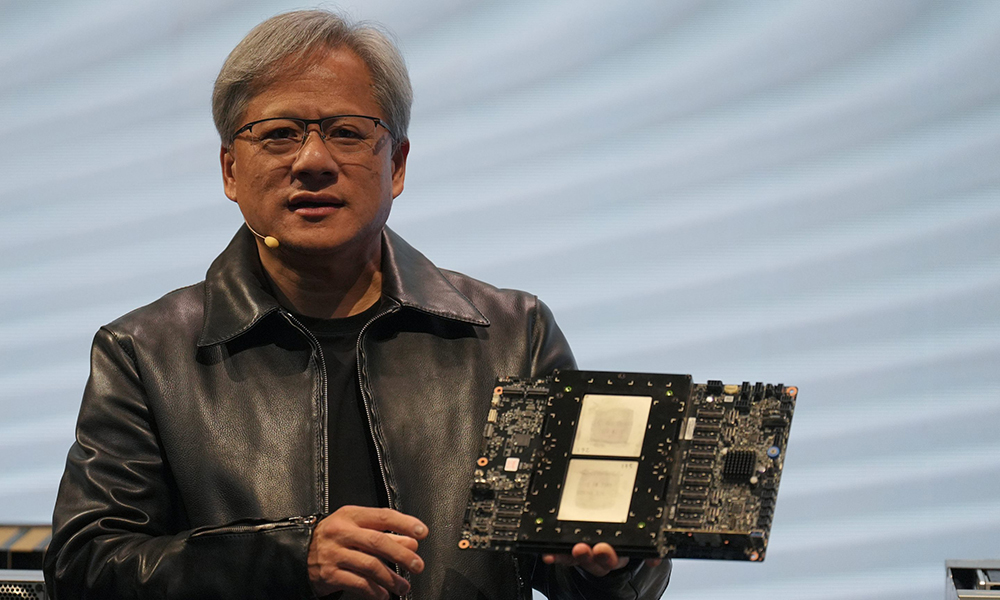
上周,半導(dǎo)體巨頭英偉達(dá)成為全球市值最高的公司,,這要?dú)w功于該公司多年前采取的明智舉措,,這些舉措為其壟斷人工智能芯片市場奠定了基礎(chǔ)。
早在登上企業(yè)界頂峰之前,,英偉達(dá)還是一家嶄露頭角的初創(chuàng)公司,,最初是由首席執(zhí)行官黃仁勛與聯(lián)合創(chuàng)始人克里斯·馬拉科夫斯基和柯蒂斯·普里姆在丹尼連鎖餐廳(Denny’s)的一個(gè)分隔用餐區(qū)構(gòu)想出來的。該公司于1993年成立后不久,,就發(fā)明了首批圖形處理器(GPU),,最初用于視頻游戲和圖形設(shè)計(jì),。
從那時(shí)起,這家公司雄心勃勃,,并逐漸發(fā)展壯大,,以至于一舉成名。該公司的名稱是拉丁語"嫉妒”一詞的雙關(guān)語,,并以3.34萬億美元的市值令蘋果(Apple),、微軟(Microsoft)和谷歌(Google)等科技巨頭望塵莫及(自今年1月以來,該公司的市值已增長了一倍多),。但它是如何達(dá)到巔峰的呢,?分析師告訴《財(cái)富》雜志,該公司取得成功的關(guān)鍵在于,,早在幾十年前就為如今席卷市場的人工智能熱潮做好了準(zhǔn)備,。
中央處理器(CPU)是最常見的計(jì)算機(jī)芯片,可追溯到20世紀(jì)50年代,,非常適合一次執(zhí)行一個(gè)復(fù)雜的計(jì)算,,但當(dāng)深度學(xué)習(xí)和人工智能研究在2010年代得到迅猛發(fā)展時(shí),中央處理器就無法滿足數(shù)據(jù)科學(xué)家的需求了,。相比之下,,英偉達(dá)的圖形處理器更能滿足人工智能的需求,原因是它們可以一次執(zhí)行許多簡單的計(jì)算,。早在2012年,,OpenAI的前首席科學(xué)家、人工智能初創(chuàng)公司Safe Superintelligence的聯(lián)合創(chuàng)始人伊爾亞·蘇茨克維(Ilya Sutskever)就已經(jīng)在使用英偉達(dá)的芯片開發(fā)名為AlexNet的早期卷積神經(jīng)網(wǎng)絡(luò),。
英偉達(dá)的芯片近年來發(fā)展迅速,,去年8月發(fā)布的GH200 Grace Hopper超級芯片如今每秒可以執(zhí)行200百億億次(200后面跟著18個(gè)零)計(jì)算。
貝雅(Baird)半導(dǎo)體高級研究分析師特里斯坦·杰拉(Tristan Gerra)對《財(cái)富》雜志表示,,英偉達(dá)之所以能夠壟斷人工智能市場,,完全要?dú)w功于首席執(zhí)行官黃仁勛多年前的及時(shí)押注。黃仁勛的先見之明之一是創(chuàng)建了通用并行計(jì)算架構(gòu)CUDA,,這是該公司在2007年開發(fā)的一款高級編程工具,,有助于以簡單直接的方式釋放圖形處理器的全部性能。
杰拉說:“英偉達(dá)的聯(lián)合創(chuàng)始人兼首席執(zhí)行官黃仁勛很有遠(yuǎn)見,,很早就發(fā)現(xiàn)了數(shù)據(jù)中心采用圖形處理器的趨勢,,并根據(jù)這一愿景調(diào)整了公司的戰(zhàn)略?!?/p>
標(biāo)普全球市場情報(bào)(S&P Global Market Intelligence)旗下451 Research的基礎(chǔ)設(shè)施分析師約翰·阿伯特(John Abbott)補(bǔ)充說,,CUDA現(xiàn)在的應(yīng)用如此廣泛,以至于構(gòu)建OpenAI的ChatGPT等大型語言模型的公司很難想象自己會使用其他技術(shù),。
阿伯特在一封電子郵件中說:"大型模型的訓(xùn)練可能需要數(shù)月時(shí)間,,因此需要大規(guī)模集群來縮短訓(xùn)練時(shí)間,。由于英偉達(dá)的圖形處理器可以隨時(shí)提供成熟的配套軟件工具,并能隨時(shí)幫助相關(guān)人員掌握使用這些工具所需的技能,,因此各大公司別無選擇,。英偉達(dá)的圖形處理器已經(jīng)成為實(shí)際標(biāo)準(zhǔn)。"
杰拉表示,,除了先發(fā)優(yōu)勢外,,該公司在技術(shù)上也占有優(yōu)勢。
杰拉表示:“英偉達(dá)提供完整的超級計(jì)算機(jī)解決方案,,包括性能最高的硬件(芯片)和軟件套件,,而競爭對手只提供人工智能芯片?!?/p>
不過,,阿伯特警告稱,英偉達(dá)在人工智能芯片領(lǐng)域的主導(dǎo)地位仍面臨著數(shù)項(xiàng)威脅,。盡管英偉達(dá)控制著大約90%的人工智能芯片市場份額,,但Meta和谷歌等一些大型科技公司已開始自研芯片以與之競爭。
該公司在中國還面臨地緣政治障礙,。美國正在限制英偉達(dá)在中國的擴(kuò)張,,而中國政府也在極力打造該公司產(chǎn)品的替代品。戰(zhàn)爭爆發(fā)的威脅也可能顛覆該公司的業(yè)務(wù),。
阿伯特表示:"臺灣是英偉達(dá)目前所有圖形處理器的來源地,,目前正受到政治威脅。持續(xù)的供應(yīng)鏈問題也是一個(gè)很大的風(fēng)險(xiǎn),?!?/p>
然而,就目前而言,,英偉達(dá)仍在高歌猛進(jìn)。該公司股價(jià)一路飆升,,并在本月早些時(shí)候制定了將股票1拆10的計(jì)劃,。自1月份以來,其漲幅已占標(biāo)準(zhǔn)普爾500指數(shù)總漲幅的三分之一,。(財(cái)富中文網(wǎng))
譯者:中慧言-王芳
上周,,半導(dǎo)體巨頭英偉達(dá)成為全球市值最高的公司,這要?dú)w功于該公司多年前采取的明智舉措,,這些舉措為其壟斷人工智能芯片市場奠定了基礎(chǔ),。
早在登上企業(yè)界頂峰之前,英偉達(dá)還是一家嶄露頭角的初創(chuàng)公司,,最初是由首席執(zhí)行官黃仁勛與聯(lián)合創(chuàng)始人克里斯·馬拉科夫斯基和柯蒂斯·普里姆在丹尼連鎖餐廳(Denny’s)的一個(gè)分隔用餐區(qū)構(gòu)想出來的,。該公司于1993年成立后不久,,就發(fā)明了首批圖形處理器(GPU),最初用于視頻游戲和圖形設(shè)計(jì),。
從那時(shí)起,,這家公司雄心勃勃,并逐漸發(fā)展壯大,,以至于一舉成名,。該公司的名稱是拉丁語"嫉妒”一詞的雙關(guān)語,并以3.34萬億美元的市值令蘋果(Apple),、微軟(Microsoft)和谷歌(Google)等科技巨頭望塵莫及(自今年1月以來,,該公司的市值已增長了一倍多)。但它是如何達(dá)到巔峰的呢,?分析師告訴《財(cái)富》雜志,,該公司取得成功的關(guān)鍵在于,早在幾十年前就為如今席卷市場的人工智能熱潮做好了準(zhǔn)備,。
中央處理器(CPU)是最常見的計(jì)算機(jī)芯片,,可追溯到20世紀(jì)50年代,非常適合一次執(zhí)行一個(gè)復(fù)雜的計(jì)算,,但當(dāng)深度學(xué)習(xí)和人工智能研究在2010年代得到迅猛發(fā)展時(shí),,中央處理器就無法滿足數(shù)據(jù)科學(xué)家的需求了。相比之下,,英偉達(dá)的圖形處理器更能滿足人工智能的需求,,原因是它們可以一次執(zhí)行許多簡單的計(jì)算。早在2012年,,OpenAI的前首席科學(xué)家,、人工智能初創(chuàng)公司Safe Superintelligence的聯(lián)合創(chuàng)始人伊爾亞·蘇茨克維(Ilya Sutskever)就已經(jīng)在使用英偉達(dá)的芯片開發(fā)名為AlexNet的早期卷積神經(jīng)網(wǎng)絡(luò)。
英偉達(dá)的芯片近年來發(fā)展迅速,,去年8月發(fā)布的GH200 Grace Hopper超級芯片如今每秒可以執(zhí)行200百億億次(200后面跟著18個(gè)零)計(jì)算,。
貝雅(Baird)半導(dǎo)體高級研究分析師特里斯坦·杰拉(Tristan Gerra)對《財(cái)富》雜志表示,英偉達(dá)之所以能夠壟斷人工智能市場,,完全要?dú)w功于首席執(zhí)行官黃仁勛多年前的及時(shí)押注,。黃仁勛的先見之明之一是創(chuàng)建了通用并行計(jì)算架構(gòu)CUDA,這是該公司在2007年開發(fā)的一款高級編程工具,,有助于以簡單直接的方式釋放圖形處理器的全部性能,。
杰拉說:“英偉達(dá)的聯(lián)合創(chuàng)始人兼首席執(zhí)行官黃仁勛很有遠(yuǎn)見,很早就發(fā)現(xiàn)了數(shù)據(jù)中心采用圖形處理器的趨勢,,并根據(jù)這一愿景調(diào)整了公司的戰(zhàn)略,。”
標(biāo)普全球市場情報(bào)(S&P Global Market Intelligence)旗下451 Research的基礎(chǔ)設(shè)施分析師約翰·阿伯特(John Abbott)補(bǔ)充說,,CUDA現(xiàn)在的應(yīng)用如此廣泛,,以至于構(gòu)建OpenAI的ChatGPT等大型語言模型的公司很難想象自己會使用其他技術(shù),。
阿伯特在一封電子郵件中說:"大型模型的訓(xùn)練可能需要數(shù)月時(shí)間,因此需要大規(guī)模集群來縮短訓(xùn)練時(shí)間,。由于英偉達(dá)的圖形處理器可以隨時(shí)提供成熟的配套軟件工具,,并能隨時(shí)幫助相關(guān)人員掌握使用這些工具所需的技能,因此各大公司別無選擇,。英偉達(dá)的圖形處理器已經(jīng)成為實(shí)際標(biāo)準(zhǔn),。"
杰拉表示,除了先發(fā)優(yōu)勢外,,該公司在技術(shù)上也占有優(yōu)勢,。
杰拉表示:“英偉達(dá)提供完整的超級計(jì)算機(jī)解決方案,包括性能最高的硬件(芯片)和軟件套件,,而競爭對手只提供人工智能芯片,。”
不過,,阿伯特警告稱,,英偉達(dá)在人工智能芯片領(lǐng)域的主導(dǎo)地位仍面臨著數(shù)項(xiàng)威脅。盡管英偉達(dá)控制著大約90%的人工智能芯片市場份額,,但Meta和谷歌等一些大型科技公司已開始自研芯片以與之競爭,。
該公司在中國還面臨地緣政治障礙。美國正在限制英偉達(dá)在中國的擴(kuò)張,,而中國政府也在極力打造該公司產(chǎn)品的替代品,。戰(zhàn)爭爆發(fā)的威脅也可能顛覆該公司的業(yè)務(wù)。
阿伯特表示:"臺灣是英偉達(dá)目前所有圖形處理器的來源地,,目前正受到政治威脅,。持續(xù)的供應(yīng)鏈問題也是一個(gè)很大的風(fēng)險(xiǎn)?!?/p>
然而,,就目前而言,英偉達(dá)仍在高歌猛進(jìn),。該公司股價(jià)一路飆升,,并在本月早些時(shí)候制定了將股票1拆10的計(jì)劃。自1月份以來,,其漲幅已占標(biāo)準(zhǔn)普爾500指數(shù)總漲幅的三分之一。(財(cái)富中文網(wǎng))
譯者:中慧言-王芳
Semiconductor giant Nvidia became the most valuable company in the world this week thanks to smart moves it made years ago that set it up to corner the AI chips market.
Long before it was at the top of the corporate world, Nvidia was a fledgling startup first conceived of in a Denny’s booth by CEO Jensen Huang with cofounders Chris Malachowsky and Curtis Priem. Shortly after it was founded in 1993, the company invented one of the first GPUs, or graphics processing units, originally for use in video games and graphic design.
Since then, the company has upped its ambitions and grown into its name, which is a play on the latin word for envy, by humbling tech giants like Apple, Microsoft, and Google with its $3.34 trillion market cap—which has more than doubled since January. But how did it get here? The key to its success, analysts told Fortune, started decades ago with its early preparation for the AI frenzy now sweeping markets.
CPUs, the most common computer chips which date back to the 1950s, are great for executing complex calculations one at a time, but they didn’t quite fit the needs of data scientists when deep learning and AI research intensified in the 2010s. Nvidia’s GPUs, by contrast, were a perfect fit for AI because they could perform many simple calculations at once. In 2012, Ilya Sutskever, OpenAI’s former chief scientist and the cofounder of AI startup Safe Superintelligence, was already using Nvidia chips for an early convolutional neural network called AlexNet.
Nvidia’s chips have progressed rapidly in recent years, and its GH200 Grace Hopper Superchip released last August can now perform 200 quintillion (200 followed by 18 zeros) calculations per second.
But Nvidia was only able to corner the market on AI thanks to timely bets made by CEO Jensen Huang years earlier, Baird semiconductors senior research analyst Tristan Gerra told Fortune. One of its prescient moves included creating CUDA, a high-level programming tool the company built in 2007 to help unlock the full capability of its GPUs in a straightforward way.
“Jensen, Nvidia’s co-founder and CEO, is a visionary and saw the trends of GPU adoption in data centers early on and aligned the company’s strategy to that vision,” Gerra said.
CUDA is now so widely used that it’s difficult for companies building large language models like OpenAI’s ChatGPT to imagine themselves using other tech, added John Abbott, an infrastructure analyst with 451 Research, which is part of S&P Global Market Intelligence.
“Large models can take months to train, and massive clusters are required to shorten that time. Because mature software tools—and the skills needed to use them—are readily available for Nvidia GPUs, there has really been no other choice. Nvidia GPUs have become a de-facto standard,” Abbot said in an email.
Apart from its early-mover advantage, Gerra said the company has a technological leg up as well.
“Nvidia provides a full supercomputer solution, including the highest-performance hardware (chips) and software suite. The competition offers AI chips only,” said Gerra.
Still, Nvidia faces several threats to its dominant position in AI chips, warned Abbot. Although Nvidia controls about 90% of the AI chips market, some big tech competitors such as Meta and Google have started producing in-house chips to compete.
The company also faces geopolitical obstacles in China. The U.S. is restricting Nvidia’s ability to expand in the country, and China’s government is trying hard to create an alternative to the company’s products. The threat of war could also upend the company’s business.
“Taiwan—from where NVIDIA sources all of its GPUs at the moment—is under political threat. Ongoing supply chain issues are also a big risk,” said Abbot.
Yet, for now, Nvidia is still riding high. Shares of the company have skyrocketed so much that the company instituted a 10-for-1 stock split earlier this month. Its gains have accounted for a third of the total value added to the S&P 500 since January.






